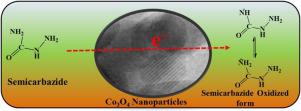当前位置:
X-MOL 学术
›
J. Ind. Eng. Chem.
›
论文详情
Our official English website, www.x-mol.net, welcomes your feedback! (Note: you will need to create a separate account there.)
Electrochemical Determination of Semicarbazide on Cobalt Oxide Nanoparticles: Implication towards Environmental Monitoring
Journal of Industrial and Engineering Chemistry ( IF 6.1 ) Pub Date : 2021-01-01 , DOI: 10.1016/j.jiec.2020.10.002 Balaji B. Mulik , Ajay V. Munde , Raviraj P. Dighole , Bhaskar R. Sathe
Journal of Industrial and Engineering Chemistry ( IF 6.1 ) Pub Date : 2021-01-01 , DOI: 10.1016/j.jiec.2020.10.002 Balaji B. Mulik , Ajay V. Munde , Raviraj P. Dighole , Bhaskar R. Sathe

|
Abstract The electrochemical determination of semicarbazide (SCB) executed by using cobalt oxide (Co3O4) nanoparticle modified electrode which was fabricated by using simple precipitation method. The as-synthesized nanoparticles have been well characterised by X-ray diffraction (XRD), Furrier transform infra-red (FTIR), UV-visible (UV-Vis) spectroscopic techniques, energy dispersive analysis of X-ray (EDAX), BET surface area, thermogravimetric (TG) analysis and transmission electron microscopic (TEM) techniques. The XRD shows face centred cubic (FCC) structure, the FTIR demonstrated a major bands appeared at 574 cm−1 and 669 cm−1 are suggesting the (Co-O) vibrational mode of Co3O4. The TEM of Co3O4 NPs has been confirmed its ultra-small particle size is of ∼2 nm ± 0.5 nm. Whereas, EDAX shows the only cobalt and oxygen are available confirms Co3O4 having high BET surface area. The fabricated Co3O4 acted as a highly sensitive electrochemical sensor for the determination of SCB by using linear Sweep voltammetry (LSV), cyclic voltammetry (CV), electrochemical impedance spectroscopy (EIS) in 0.5 M KOH solution. Significantly, anodic onset potential observed at 0.2 V vs. SCE, linear range of scan rate and concentration (1 mM–100 mM) with (LOD 0.13 and LOQ 0.46) and high current and potential stability with pH dependent behaviour confirms Co3O4 based electrocatalytic system is good for oxidative determination of SCB. The selectivity of the sensor also tested by using mixture of other environmental active species with SCB by using LSV measurements. This proposed system is applicable in food and pharmaceutical industries for the determination of SCB as an amperometric sensor.
中文翻译:

氧化钴纳米颗粒上氨基脲的电化学测定:对环境监测的影响
摘要 采用简单沉淀法制备的氧化钴(Co3O4)纳米颗粒修饰电极对氨基脲(SCB)进行电化学测定。合成的纳米粒子已通过 X 射线衍射 (XRD)、傅里叶变换红外 (FTIR)、紫外-可见 (UV-Vis) 光谱技术、X 射线能量色散分析 (EDAX)、BET 进行了很好的表征表面积、热重 (TG) 分析和透射电子显微镜 (TEM) 技术。XRD 显示面心立方 (FCC) 结构,FTIR 显示在 574 cm-1 和 669 cm-1 处出现的主要带表明 Co3O4 的 (Co-O) 振动模式。Co3O4 NPs 的 TEM 已证实其超小粒径为~2 nm ± 0.5 nm。然而,EDAX 显示只有钴和氧可用,证实 Co3O4 具有高 BET 表面积。通过使用线性扫描伏安法 (LSV)、循环伏安法 (CV)、电化学阻抗谱 (EIS) 在 0.5 M KOH 溶液中,制备的 Co3O4 可用作测定 SCB 的高灵敏度电化学传感器。值得注意的是,在 0.2 V vs. SCE 下观察到的阳极起始电位、扫描速率和浓度的线性范围(1 mM-100 mM)与(LOD 0.13 和 LOQ 0.46)以及具有 pH 依赖性行为的高电流和电位稳定性证实了基于 Co3O4 的电催化系统有利于 SCB 的氧化测定。通过使用 LSV 测量,还通过使用其他环境活性物质与 SCB 的混合物来测试传感器的选择性。
更新日期:2021-01-01
中文翻译:

氧化钴纳米颗粒上氨基脲的电化学测定:对环境监测的影响
摘要 采用简单沉淀法制备的氧化钴(Co3O4)纳米颗粒修饰电极对氨基脲(SCB)进行电化学测定。合成的纳米粒子已通过 X 射线衍射 (XRD)、傅里叶变换红外 (FTIR)、紫外-可见 (UV-Vis) 光谱技术、X 射线能量色散分析 (EDAX)、BET 进行了很好的表征表面积、热重 (TG) 分析和透射电子显微镜 (TEM) 技术。XRD 显示面心立方 (FCC) 结构,FTIR 显示在 574 cm-1 和 669 cm-1 处出现的主要带表明 Co3O4 的 (Co-O) 振动模式。Co3O4 NPs 的 TEM 已证实其超小粒径为~2 nm ± 0.5 nm。然而,EDAX 显示只有钴和氧可用,证实 Co3O4 具有高 BET 表面积。通过使用线性扫描伏安法 (LSV)、循环伏安法 (CV)、电化学阻抗谱 (EIS) 在 0.5 M KOH 溶液中,制备的 Co3O4 可用作测定 SCB 的高灵敏度电化学传感器。值得注意的是,在 0.2 V vs. SCE 下观察到的阳极起始电位、扫描速率和浓度的线性范围(1 mM-100 mM)与(LOD 0.13 和 LOQ 0.46)以及具有 pH 依赖性行为的高电流和电位稳定性证实了基于 Co3O4 的电催化系统有利于 SCB 的氧化测定。通过使用 LSV 测量,还通过使用其他环境活性物质与 SCB 的混合物来测试传感器的选择性。


























 京公网安备 11010802027423号
京公网安备 11010802027423号